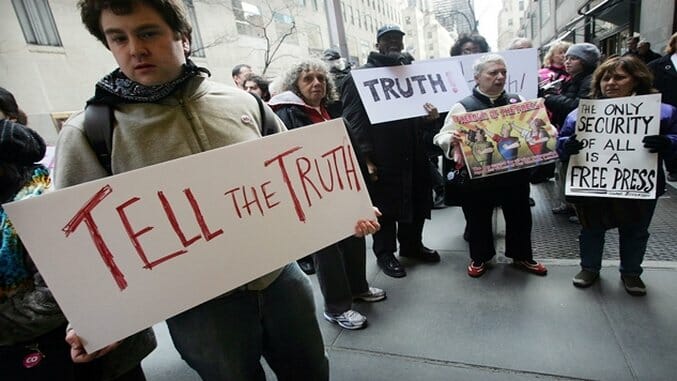From Trump to Police Shootings: Mainstream Media Has an Obligation Not to Regurgitate the Official Line Without Context or Skepticism
The Over-reliance on Official Sources, and the Pratfalls of False Objectivity
Media Features Mainstream Media
Reporters will likely have less direct access to the President-elect than any administration in modern history. President-elect Donald Trump hasn’t held a traditional press conference since July. Since the election, his biggest olive branch to the press was inviting news celebrities to a useless off-the-record meeting at his Mar-a-Lago estate in Palm Beach, Fla. Photos were, naturally, allowed. What remains is a one-direction communication channel of outbursts, unfounded claims, outright lies, and falsehoods that stream from the president-elect’s Twitter account. It leaves little room for rebuttal, follow-up, or challenge. In this environment, reporters will have an even greater responsibility not to simply repeat and report his flexible truths without context, verification, and skepticism.
Blind service to the ideas of “fairness” or “objectivity” at the opposition of verifiable truth is neither fair nor objective, and instead presents false equivalencies. Imagine a debate between the Flat Earth Society and Magellan, with reporters giving equal time and credence to both side’s statements. Now look at the mainstream media’s treatment of a verifiably false tweet from Trump last year. The tweet re-tweeted a photo, that’s since been deleted, that claimed 81 percent of murdered white people are killed by black people-a lie that originated with a white supremacist on Twitter. The actual stats, according to the FBI, are basically the opposite: Whites killed by blacks, 15 percent. Whites killed by whites, 82 percent. Dismayingly, Fox News wrote, “Trump Tweet on Black Crime Sets Off Firestorm.” The Hill reported “Trump Takes Heat for Tweet About Black Murder Rates,” and on and on.
The lie was reported ad nauseum without immediate disclaimers. The Hill did address the truth in the lower body of its story. But a flood of headlines—shared, clicked, and streamed across social media—can mutate outright lies or “truthiness” into something resembling consensus.
The obligation does not begin or end with coverage at the Trump White House. Media’s reluctance to stray from official statements has been clear in the mainstream coverage—often without clarification, context, or rebuttal—of topics ranging from police shootings of unarmed black civilians to the Dakota Access Pipeline protests.
In the case of the Dakota pipeline protests, official reports from the sheriff’s office often defended, minimized, or omitted violent treatment of protesters. The wealth of photo and video evidence available that rebutted sheriff’s reports should have been enough to lend skepticism to the coverage. CNN and other mainstream outlets repeated the claims from law enforcement that the water cannon used against protesters in below-freezing temperatures was a response to fires set by “armed protesters.” Again, video evidence points to the contrary.
The New York Times wrote a story on the 21-year-old protester who nearly lost an arm to an explosion. The piece included information on the shrapnel in the protesters arm which will be analyzed to determine the source of the blast. Still, nearly a month later there has been no follow-up to definitively determine whether it was a police grenade, or a protester-made improvised explosive device.
Oftentimes a hands-that-feeds relationship between reporters and officials, especially in cases of criminal investigations where all initial information comes from law enforcement, leads to an unhealthy balance of regurgitation versus actual verification. This can be an understandable trap for local beat reporters who maintain day-to-day relations with government officials. But the national media, once it has decided to make a local story national, has no such excuse, and no day-to-day relationships to preserve. So what happens when reports parrot the official line even when there is clear evidence contradictory to the official statement?
The dissonance between an official line and reality was revealed in several civilian shootings by police, including Laquan McDonald in Chicago. The reality of events depicted by squad car dash cam videos starkly clash with official police reports.
As reported by the Chicago Tribune, officers at the scene wrote reports in direct conflict with the reality captured on video. Officers stated that McDonald was acting “crazed,” and that he was shot as he “swung (a) knife toward the officers in an aggressive manner.” The reports stated that McDonald, with a knife in his hand, “raised his right arm toward Officer Van Dyke as if attacking Van Dyke.” The video shows a stark difference: Van Dyke shooting McDonald 16 times in the back as he walked away from officers, well out of striking distance. The report goes on to state, fictitiously, that McDonald “fell to the ground but continued to move, attempting to get back up, with the knife still in his hand.”
It begs the question, if the video had come from a bystander and not an official dash cam, would the major news outlets have reported it at all?
The Tribune’s continued efforts like its lawsuits to force the release of Chicago official’s emails, have shed necessary light on the story. But it was a largely unknown, independent journalist named Brandon Smith who initially sued the City of Chicago and forced it to release the dash cam videos. This was the falling domino which led to murder charges against Jason Van Dyke and the formation of a recent grand jury to investigate possible corruption charges in the shooting’s cover-up.
In Chicago, Brandon Smith stepped in when the established journalism outlets were not scrutinizing the institutions we depend on to cover. In Washington, reporters will face an even more difficult challenge in the Trump White House, separating the silt of fiction from the nuggets of truth and not giving equal weight to both.